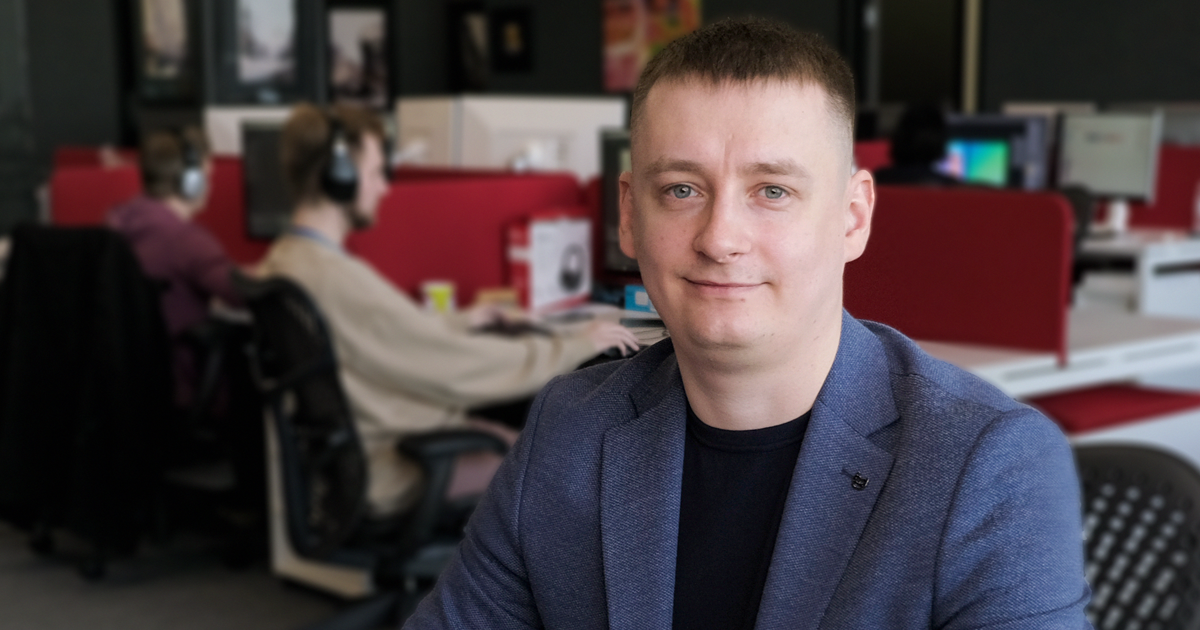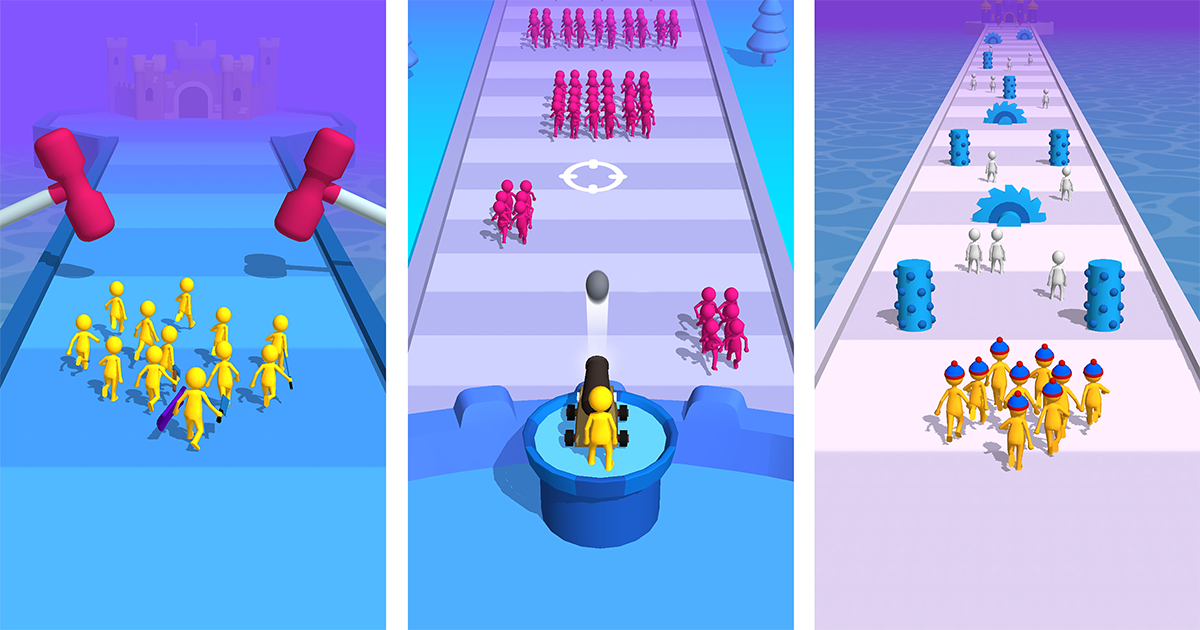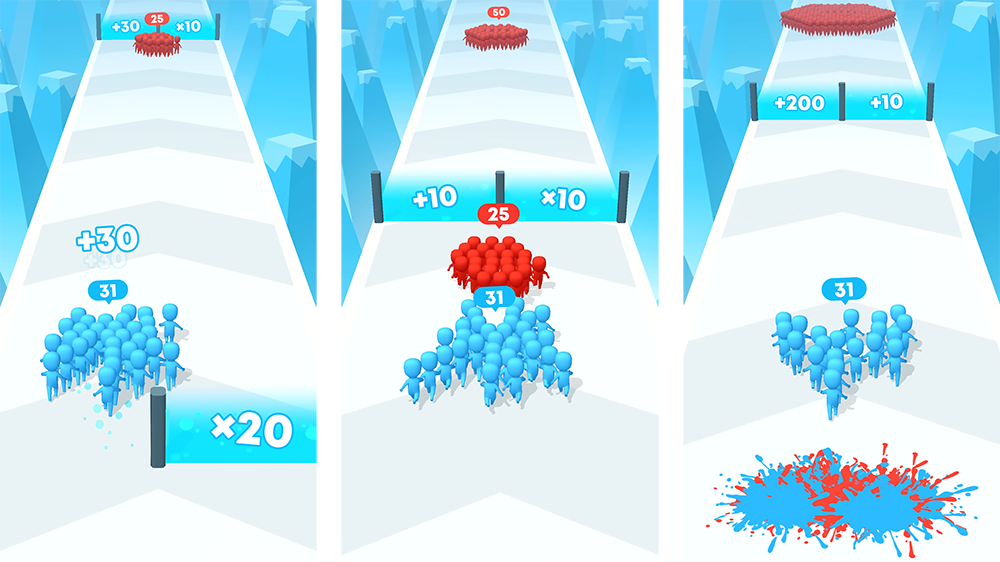Downloads of the Belarusian FreePlay studio have reached almost 500 million. Most of it — 290 million — falls on the hyper-casual hit Join Clash. About the history of the studio and its approach to development App2Top.ru I talked to one of the founders and CEO of FreePlay.
Evgeny Sidorov, Founder and CEO of FreePlay
Alexander Semenov, Editor-in-Chief App2Top.ru : Zhenya, hi. Tell us how it all started, how did you get into the industry, how did you launch the studio?
Evgeny Sidorov, Founder and CEO of FreePlay: Hi, Sasha. If you start with a personal story, then I came to the industry 5 years ago. I started with game design, then did a little product development.
What did you do before the games?
Evgeny: I worked in a completely different field, in the real sector, as they say. I was looking for myself, trying to understand what the soul is for. And over time, I realized that I wanted to make games.
I’ve always been fond of games, and I’ve had a lot of gaming experience. Moreover, since school I have participated in all kinds of Counter-Strike and Warcraft competitions.
There was also an idea of the market and the industry, although I did not understand how the development was being carried out, how then the games were on the market, and so on.
In general, when searching for myself, I suddenly became interested in how the gaming market works, how games are created. Slowly began to understand, go to various courses. Over time, I came to the idea that it was mine.
You’ve played Counter-Strike and Warcraft, but you’ve taken up mobile games. Why did this happen?
Evgeny: The mobile market is a little simpler and more budget-friendly in terms of development. The entry threshold is lower here.
To enter the market of “big” games, you need a lot of money or a lot of experience. Better, the first and the second at once.
I decided that I would move forward. I will not rush, I will start with mobile, and then, perhaps, I will be able to take up games for PC and consoles.
In other words, did you come to mobile right away with the idea to create a business?
Evgeny: Of course. Having gained a little experience, I almost immediately assembled a team. Mostly from guys I know. Then we started developing casual games.
It turns out that the old case was not a source of funding for either you or the team?
Eugene: Oh no. At first, we all worked only on enthusiasm. Someone had a financial cushion, someone continued to work at the same place, developing games in their spare time.
Then we found investors and co-founders. They allowed us to move on to full-fledged work on several projects at once.
And who are your investors and co-founders?
Evgeny: They are not ready to declare themselves publicly yet. These are Belarusian technology investors.
By the way, how did the family react to the fact that you took up game development?
Evgeny: I’m not married, as for my parents, what could they say? They shrugged their shoulders. Say, study.
How easy was it to launch a development business in Minsk?
Evgeny: With the advent of HTP, much more product teams appeared in Belarus: the new Decree helped this. Actually, this has increased interest in the technology sector and startups in general, many more developers have appeared, the labor market in this area has noticeably changed.
Many procedures have been simplified — from hiring to accounting, and the rules of English law concerning the attraction and registration of investments have also been added.
Is it also about foreign investors?
Evgeny: Yes. Now this is quite a common story with us. Some of our startups attract investments from Russian, Ukrainian and Lithuanian funds.
So, you became a team, you got money. What’s next? Did you immediately take up hyper-casual projects?
Evgeny: No. We started with casual projects with a relatively long development time.
Relatively large — how much is it?
Eugene: 4 months.
It’s not that much.
Evgeny: We had a team of 8 people. To do a project for 3-4 months, get the first figures and understand that everything should be thrown away and start from the very beginning is long and expensive.
It was a good experience that allowed us to understand how the market works, to feel out what and how it makes sense to produce on it.
But at the same time, from a business point of view, this approach did not pay for itself. We made games for a long time, which then had to be quickly closed due to indicators that did not suit us.
How quickly did you switch to a different production model, to hyper-casual games?
Evgeny: In 7-8 months. Already in the fall of 2019, we started working on hypercausal prototypes. By the end of the year, we had Join Clash on our hands.
Join Clash
Do you remember how we came to this concept?
Evgeny: We have been closely monitoring the market, trying to analyze what is happening on it. We tracked what is popular now, made predictions about what might become popular after some time.
We can say that Join Clash just came out of analytical work. We took three popular mechanics at that time and combined them:
- a mechanic where the player runs through an obstacle course;
- mechanics with the collection of little men in a large crowd;
- a battle without direct control (armies collide and fight).
This is how the Join Clash turned out.
An interesting approach. It seemed to me that more often hyper-casual commands come to new mechanics through viewing trends in TikTok. In the spirit of: “It has become fashionable to show how you squeeze paste out of a tube, let’s quickly make a game about it.”
Evgeny: We also follow trends, TikTok, YouTube, which games are coming out, which are becoming popular. Without this, it is impossible in the market.
But here it is important to note that there are two approaches to the development of hyper-casual games:
- clone development;
- rethinking existing mechanics and concepts, creating a new gameplay based on them.
We adhere to the second approach. We take, change, try to apply familiar approaches from a new angle.
How did you know that you had a hit on your hands? When did you see the metrics?
Evgeny: We didn’t have a hit in our hands right away.
We made the game in two weeks and started testing it. From the point of view of marketing, the game showed very good results. The purchase cost turned out to be very small, somewhere in the region of eight cents in the USA.
The situation was quite different with the retention of the first day. It was at the level of 20%. This is not a failed indicator, but it cannot be called a good one either.
We didn’t get upset. We understood that we were facing an interesting task — to finish the game performance of a product that can be called outstanding in terms of marketing potential.
We began to actively refine the build. They changed concepts, mechanics, key chips. Each iteration was tested, the most working ones were selected, demonstrating the best result.
So we got the release version of Join Clash.
Did you expect the game to collect 290 million installs?
Evgeny: Of course not. Looking back at the successes of my colleagues, I thought that at best we would raise 20 million. This could be considered a success.
But the numbers turned out to be completely different in the end.
Evgeny: Yes, we could not predict such a result.
When we launched the first campaign, and then began to scale it, downloads quickly piled up.
And then we faced a choice.
We understood that the lifespan of most hyper-casual games is 1-2 months. The game hangs in the top for a while, and then disappears from it.
It was possible either to put up with it, dealing with new products, or to continue to refine and maintain it.
And what did this practice lead to?
Evgeny: As we expected, after a few months the indicators of Join Clash went down. However, due to the fact that we were constantly refining the game, improving it, we were able to buy more and more expensive users in six months. The project paid off better, his campaign scaled better. In fact, the game got a second life.
And we still do not give up the game, we are actively developing and supporting it.
Was there any risk in this? After all, the project could not take off again?
Evgeny: If we were dealing exclusively with one product, then such a model would look risky. But simultaneously with the completion of Join Clash, we were engaged in new products, testing new hypotheses, mechanics. Before the game “shot” for the second time, we managed to release several new games.
When they talk about operating traditional mobile games, everything is usually clear: there are seasonal updates, support for linear progression with new levels or maps. With hyper-casual games, everything seems much less obvious. Tell me, how did you update the game?
Evgeny: One of the most significant updates of Join Clash is a meta—game. We have added a construction mode so that the player has a goal that works for engagement. It motivates the user to return to the game.
Just running, dodging and fighting can get boring quickly. Doing all this for the sake of accumulating resources, which you can then spend on building your own base or town, is a completely different story.
In the first iteration of meta, there were only six buildings. We did it quickly just to understand whether it affects retention or not.
As it turned out, it does. After that, we started developing meta: adding new buildings (now there are about 70 of them there), expanding the map, polishing.
How often does this approach in development occur in the hyper-casual games market?
Evgeny: The main feature of hyper-casual games from the point of view of the business model: you can quickly make a product, buy users for ten cents apiece and recapture this money on advertising.
The model is working. Plus or minus stable. That is why there are so many companies and so many clones in the niche now, because with this approach, the originality of mechanics is secondary. The main thing is whether you managed to take advantage of her popularity or not.
However, those studios that can afford to refine games, which are engaged in their constant improvement, respectively, and produce stronger products, in which meta and other original features appear over time.
Two years ago you started with 8 people. How many of you are there now?
Evgeny: About 50 people. They are distributed among three studios. One in Moscow, two in Minsk.
Do you think it’s a lot or a little?
Evgeny: Let’s figure it out. At first glance, for a studio that makes hyper-casual games, this is a lot.
On the other hand, each internal studio is working on its own line of projects. Plus, they also support already released titles. In addition, we have our own analytics department, monetization department, marketing department, and our own QA.
So for a studio that publishes its own games, 50 employees is the optimal figure. You can even do more.
You mentioned that each studio is working on its own set of games, and even supports those that have already been released. How many projects are you running at once?
Evgeny: We have about 8-10 projects at the peak at the same time. This is taking into account both support, and prototypes, and games that are being tested.
How many stages does your game need to go through to get into the release?
Evgeny: In different ways.
There are two approaches to the development of hyper—casual games – quantitative and qualitative.
In the first case, we are talking about a conveyor. In-line production of concepts and prototypes. Here people, as a rule, do not quite understand what they are doing. They stamp and that’s it. And as soon as they see that some game shows a result above average, immediately the game is taken into circulation, combed, polished and released to the market.
In the second case, the work is built differently. The team understands the market, understands trends, it can afford to try to work ahead of the curve and, thanks to this, even work a little longer on a prototype. Let’s say not a week, but 3-4 weeks.
The quantitative and qualitative approach have different funnels and different conversions. In the first case, it is good if 1 out of 50 projects will survive until the release. As for the second approach, if there is experience and good expertise, then the level when one excellent product accounts for 10 failures can be worthy.
Many mobile developers who have achieved great success tend to go into publishing. Do you have such ambitions?
Evgeny: Yes, rather than no. But not in the classic format, when the publisher is exclusively engaged in filling traffic and is not ready to help with expertise.
We are interested in long-term cooperation, we are ready and want to dive into the products of partners, help improve metrics.
On the other hand, we don’t want developers lining up for us. We are interested in a close partnership with a small number of studios.
Otherwise, there is no point in taking it on. From my experience working with such publishers, I know that they cannot physically devote time to all developers. Only the time for some banal answers can take more than 2-3 days.
At the same time, did you publish your main blockbuster not by yourself, but with Supersonic?
Evgeny: We also planned to launch Join Clash on our own. Moreover, we launched it, even started an advertising campaign. Independently entered the world top 20. And then Supersonic contacted us and made a very interesting offer.
But now we are focused exclusively on publishing on our own. Having scored 100 million installations of Count Masters and 40 million of Fidget Toys Trading, we launched and run ourselves.
Count Masters
So, you can’t say that you were unhappy with Supersonic?
Evgeny: No, the company has done an amazing job. We are very grateful to them.
So, you are now releasing hit after hit, looking for new partners. What’s next?
Evgeny: Enter the top 5 publishers worldwide.
For how long?
Evgeny: It will be nice if we can do it in 2-3 years.
I like your attitude. Good luck!
Evgeny: Thank you!



